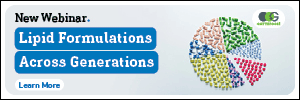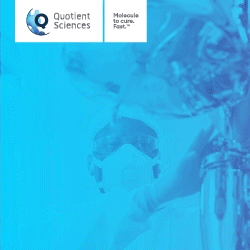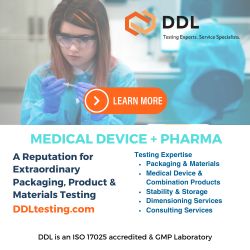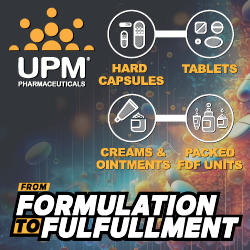Drug Delivery
Pfenex Announces US Commercial Launch of Teriparatide Injection
Pfenex Inc. recently announced that its commercialization partner, Alvogen, has launched Teriparatide Injection in the US. Teriparatide Injection (also referred to as PF708 and Bonsity)…
Glyscend Therapeutics Completes $20.5-Million Financing Round to Advance Novel Oral Polymer Therapy
Glyscend Therapeutics recently announced the closing of a $20.5-million Series A financing round. Healthcare investors Brandon Capital Partners, through its Medical Research Commercialisation Fund (MRCF),…
Daré Bioscience Announces Receipt of $1.5 Million Under the Current Grant Supplement Award for Continued Development of User-Controlled Long-Acting Reversible Contraceptive
Daré Bioscience, Inc. recently announced the receipt by its wholly owned subsidiary of $1.5 million in additional grant funding from the Bill & Melinda Gates…
Vectura Signs License & Development Agreement With Aerami Therapeutics
Vectura Group plc recently announced the signing of a global license and development agreement with Aerami Therapeutics Inc. for inhaled….
Immunic Announces FDA Allowance of its Phase 2 Trial of COVID-19 Drug
Immunic, Inc. recently announced receipt of regulatory allowance from the US FDA to initiate its Phase 2, CALVID-1 clinical trial of IMU-838, the company’s selective…
CURE Announces Exercise of Warrants; Obtains Valuable Proprietary Formulation & Dosage Technology
CURE Pharmaceutical Holding Corp recently announced it strengthened its balance sheet with the receipt of $1.4 million in cash from the exercise of warrants to…
SPECIAL FEATURE - Outsourcing Formulation Development & Manufacturing: Specialized Capabilities for Small & Large Molecules
Contributor Cindy H. Dubin interviews key players in the CDMO market who present case studies about how they are helping pharmaceutical and biopharma companies overcome a variety of formulation and manufacturing challenges.
PFS MANUFACTURING - Prefilled Syringes & Biologics: The Perfect Partnership of Medicine & Delivery
Anish Parikh charts the twin rise of biologics and PFS, outlines some of the common challenges associated with filling and dispensing, and discusses how a patient-centric partnership approach can help biopharmaceutical companies shorten the development pathway and ensure a reliable supply of safe, effective medicines for the people who need them.
GENE THERAPY - The Role Viral Vectors Play in Current Gene Therapy Development
Dieter Lingelbach, MBA, discusses the history and science of viral vectors, their current applications, and why they are a vital component in contemporary gene therapy development.
FORMULATION FORUM - Application of Captisol® Technology to Enable the Formulation of Remdesivir in Treating COVID-19
James Pipkin, PhD, Vince Antle, PhD, and Rebecca Garcia-Fandiño, PhD, explain why more Captisol® than ever is required to meet Gilead’s bold goals of making remdesivir available to COVID-19 patients in the US and to hundreds of countries around the world.
FORMULATION DEVELOPMENT - Formulating Immediate-Release Tablets for Poorly Soluble Drugs
Gayatri Khanvilkar, MPharm, Ajit Bhagat, Sangmesh Torne, PhD, Tejas Gunjikar, PhD, and Amina Faham, PhD, present a case study showing that previously unviable APIs can be successfully processed with the right methods, which should give hope to formulators facing similar difficulties.
FORMULATION FORUM - Rational Design of Oral Nanosuspensions for Insoluble Drugs
Jim Huang, PhD, explains how nanosuspensions are an important class of pharmaceutical dosage forms, particularly for pharmaceutical compounds with solubility and bioavailability challenges.
EXECUTIVE INTERVIEW - Adare Pharmaceuticals: A Virtual Acquisition is Possible
Ajay Damani, VP of Pharmaceutical Technologies Business Unit, Adare, and Maria Flynn, President and CEO, Orbis, discuss how both companies will benefit from the acquisition, future product development, and the challenges of a virtual acquisition.
GLOBAL REPORT - 2019 Global Drug Delivery & Formulation Report: Part 4, The Drug Delivery and Formulation Pipeline
In part 4 of this 4-part series, PharmaCircle, in collaboration with Drug Development & Delivery, analyzes the pipeline with an emphasis on clinical-stage products for which there is more product-related information.
Evonik Launches Platform of Custom Functional Excipients to Precisely Control the Release Profile of Parenteral Drug Products
Evonik recently announced the launch of the RESOMER Precise platform of custom functional polymeric excipients to allow pharmaceutical companies to control…
NOVA Thin Film Pharmaceuticals & Quality Chemical Laboratories Announce Partnership in Formation & Commencement of Soluble Thin Film Operations
NOVA Thin Film Pharmaceuticals LLC (NTFP) recently announced its formation and the commencement of its soluble thin film operations……
WEBINAR ALERT- From Diluent to Differentiator: How to Choose a Diluent System That Differentiates Your Lyophilized Product
Along with a rapidly expanding global market for innovative lyophilized biologics come increased cost and competitive pressures. Today, it is critical that….
Microfluidics Enables Reliable siRNA Drug Delivery for Inflammatory Diseases & Tumor Targeting
Researchers in the Department of Pharmacy at the Ludwig Maximilian University of Munich are using chips from Dolomite Microfluidics to reliably and consistently produce monodisperse…
SeraNovo Enters Second License Agreement With Carna Biosciences
SeraNovo B.V. recently announced it has signed a second License Agreement with Carna Biosciences, Inc., a company engaged in the drug development of….
Almac Discovery Enters Into Licensing Agreement for the Development & Commercialization of ALM301
Almac Discovery, a member of the Almac Group, recently announced an out-licensing partnership with an undisclosed biotechnology company in order to advance the development and…
What are Drug Delivery Systems?
Drug delivery systems are engineered technologies for the targeted delivery and/or controlled release of therapeutic agents. The practice of drug delivery has changed significantly in the past few decades and even greater changes are anticipated in the near future. Drug delivery includes but is not limited to oral delivery, gene/cell delivery, topical/transdermal delivery, inhalation deliver, parenteral delivery, respiratory delivery, capsules, particle design technology, buccal delivery, etc.
The Evolution of Drug Delivery Systems
Drug delivery systems have greatly evolved over the past 6 decades. In the past 12 years specifically, there have been huge advancements in drug delivery technology. For instance, advanced medication delivery systems, such as transdermal patches, are able to deliver a drug more selectively to a specific site, which frequently leads to easier, more accurate, and less dosing overall. Devices such as these can also lead to a drug absorption that is more consistent with the site and mechanism of action. There are other drug delivery systems used in both medical and homecare settings that were developed because of various patient needs and researchers continue to develop new methods.
Drug Delivery System Market Size
The pharmaceutical drug delivery market size is studied on the basis of route of administration, application, and region to provide a detailed assessment of the market. On the basis of route of administration, it is segmented into oral delivery, pulmonary delivery, injectable delivery, nasal delivery, ocular delivery, topical delivery, and others.
The estimated global market size of drug delivery products was $1.4 trillion in 2020. Unfortunately, 40% of marketed drugs and 90% of pipeline drugs (mostly small molecules) are poorly soluble in water, which makes parenteral, topical, and oral delivery difficult or impossible. In relation, poor solubility often leads to low drug efficacy. Add in the fact that many other hurdles exist in the form of drug loading, stability, controlled release, toxicity, and absorption – it’s not hard to understand the difficulties in bringing new drug products to market. Additionally, biopharmaceuticals (proteins, peptides, nucleic acids, etc) and combination drug products possess many of these same problematic obstacles that affect efficacy. These challenges, coupled with the complexity and diversity of new pharmaceuticals, have fueled the development of a novel drug delivery platforms that overcome a great many bioavailability and delivery obstacles. By leveraging these platforms, pharmaceutical and biopharmaceutical companies can improve dosing accuracy, efficacy, and reproducibility in their drug discovery and drug delivery research.
Drug Delivery System Demand
The demand for pharmaceutical products worldwide is only going to increase in the coming years, as old and emerging diseases continue to threaten the well-being of people globally. Drug discovery efforts are expected to intensify, generating a large variety of active compounds with vastly different structures and properties. However, it is well known that despite tremendous output of the drug discovery process, the success rate of a candidate compound becoming an approved drug product is extremely low. The majority of candidate compounds are discarded due to various hurdles in formulation and preclinical testing (such as issues with solubility, stability, manufacturing, storage, and bioavailability) before even entering into clinical studies. Therefore, advances in formulation and drug delivery, especially the development of new and versatile biomaterial platforms as effective excipients, may salvage many “difficult,” otherwise triaged, drug compounds, and significantly enhance their chance of becoming viable products. Furthermore, breakthroughs in biomaterial platform technologies will also facilitate life cycle management of existing APIs through reformulation, repurposing of existing APIs for new indications, and development of combination products consisting of multiple APIs.















